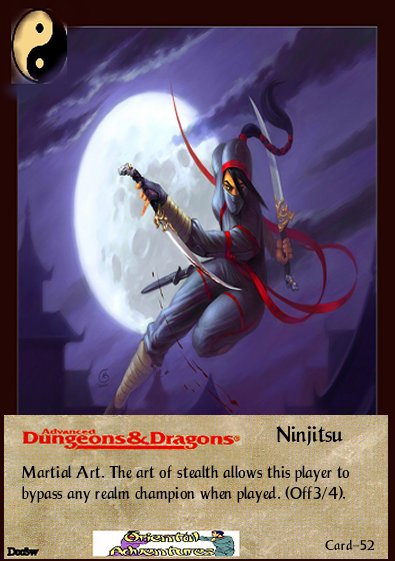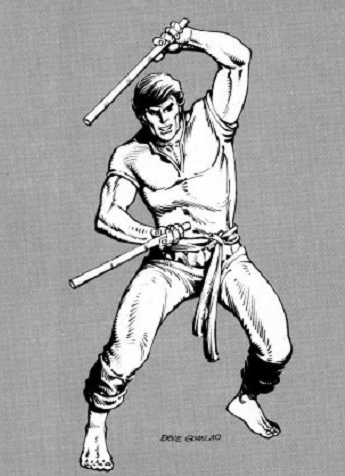who had a need for protection but were
not allowed to carry weapons. Since they
could legitimately carry farming tools in
public, farmers created a style that made
use of these tools in a combative form.
The walking stick became the bo stick, the
grain flail became the nunchaku, the
churn handle became the tui-fa, and the
hay blade became the kama. The sai,
which resembles several blacksmith tools,
was specifically designed to catch and lock
a sword. There were originally no schools
of kobu-jutsu; instead, the peasants would
gather together at night to practice their
art and trade hard-won knowledge of
proper combat techniques. Needless to
say, the disclosure of this art would mean
the further restriction of the meager
weapons the farmers carried. As a result,
kobu-jutsu practitioners operate in a highly clandestine manner and do not openly
display their art except in a life-or-death
situation.
Ninjutsu (nin-joot'soo)

NUMBER OF ATTACKS: 2/1
DAMAGE: 1-8
AC: 7
PRINCIPAL ATTACK: Hand
SPECIAL MANEUVERS: Lock 3. Movement 2,5. Strike 1. Throw 1,3. Vital area 1,2. Mental 2,4.
WEAPONS: None.
This is the unarmed combat of ninja
characters. It is commonly employed as a
last resort, however, since ninjas prefer to
fight with weapons.
The art is usually used to get an opponent out of the way so the ninja can pass
by or escape. Throws and nerve strikes
are more effective for this purpose than
regular kicks and punches. Maneuvers
from Movement and Mental and Physical
Training (Table 70, page 103, Oriental
Adventures) also show the need for practical applications in tight situations.
Pentjak-silat (pent-zhok see'-lot)
NUMBER OF ATTACKS: 2/1
DAMAGE: 1-8
AC: 6
PRINCIPAL ATTACK: Hand and foot
SPECIAL MANEUVERS: Kick (circle kick). Lock 1. Move 1,2,5. Throw 1,2,3,4. Mental 4.
WEAPONS: Scimitar, Whip
The national defense sport of Indonesia
has its base in combat forms of the 6th
century A.D. Most schools train their students (pandeka) to be proficient with both
the scimitar and whip. The pandeka do
not need weapons to be formidable, however. Their flowery, leaping art can send
devastating blows to an opponent from
any angle and from any position. Pandeka
have developed ground fighting to deadly
levels; they actually prefer taking an opponent to the ground (usually landing on top
of them) and finish the fight from that
position. Pandeka do not need to be standing to perform any of their special abilities
and can leap from a prone position.
Savate (sah-vat')
NUMBER OF ATTACKS: 2/1
DAMAGE: 1-8
AC: 8
PRINCIPAL ATTACK: Foot
SPECIAL MANEUVERS: Kick 1(circle kick),2,3
WEAPONS: None
The national sport of France, savate is
the only martial arts style native to Europe
that still exists in both sport and combative form. Savate was created by street
brawlers in the 17th century and was
systematized in post-Napoleonic France.
Classic savateurs studied with the fencing
foil or, when weapons were legally barred,
the walking cane. These weapons were
used to supplement close melee combat,
but after using their long-range kicks to
close the gap, there was usually no need
for the savateurs to continue the fight.
Shotokan (sho'-to-kahn)
NUMBER OF ATTACKS: 2/1
DAMAGE: 1-8
AC: 8
PRINCIPAL ATTACK: Hand
SPECIAL MANEUVERS: Kick 1. Movement 1,3. Strike 1,2,3. Mental 1.
WEAPONS: None
This style of karate uses linear attacks
more than circular motions. Strong
stances are learned (see Movement 3,
Oriental Adventures, page 103), whereas
flashy, high kicks are discouraged. Otherwise, this style is similar to karate as
detailed in Oriental Adventures.
Sumai (soo'-my or s’my)
NUMBER OF ATTACKS: 2/1
DAMAGE: 1-6
AC: 7
PRINCIPAL ATTACK: Body or hand
SPECIAL MANEUVERS: Movement 3. Push 1,2. Strike 1,2. Throw 1,3,4. Mental 1,5.
WEAPONS: <?>
Sumai, or sumo wrestling, is the national
sport of Japan. An ancient wrestling art,
sumai is practiced by men of large size
(rikishi) who use their bodies to push and
throw their opponents. As a sport, sumai
requires a rikishi to force an opponent
onto the mat or out of the ring. Sport
wrestlers are not taught the punches and
kicks which were originally included in
ancient sumai.
Combatant sumai in its ancient form,
however, relies on sweeps, stunning slaps,
and throws to crush opponents. Combative sumai also allows iron fist and crushing blow maneuvers (Strike 1 and 2) as
shown on page 103 of Oriental Adventures. This combination of fighting technique with such sheer mass results in a
lethal and often underrated martial arts
style. Although sumai was traditionally
limited to male practitioners, there is no
reason that women rikishi could not exist
in an AD&D game campaign.
Sumo wrestlers are unusually tall and
powerfully built, and are selected for their
size and physique. They are trained and
conditioned to reach gargantuan proportions in stature and power. Rikishi are not
the fat slobs so often portrayed in modern
media; rather, they are highly skilled warriors practicing a devastating style.
Because of the art’s emphasis on weight
and size, sumo wrestlers increase in
strength and constitution as cavaliers do
(see Unearthed Arcana). Bushi characters
are the most common practitioners of this
style.
Thai kick boxing (tie)
NUMBER OF ATTACKS: 2/1
DAMAGE: 1-8
AC: 7
PRINCIPAL ATTACK: Legs and arms
SPECIAL MANEUVERS: Kick 1(circle kick),2,3. Move 1. Strike 1.
WEAPONS: None
Thai kick boxing (muay thai) was developed in Thailand to supplement the pike
and sword in close-range fighting. There
are no set forms (kata) to muay thai, and
training consists of constant sparring and
heavy bag work. Muay thai is a brutal but
highly effective art. Thai boxers use their
feet and hands to block and push, but the
real power lies in their shin and elbow
strikes (which slam into opponents with
devastating force). Thai kick boxing is not
a pretty style, but it has become the single
most popular spectator sport in Thailand.
Furthermore, its champions are seen as
national heroes.
White crane
NUMBER OF ATTACKS: 1/1
DAMAGE: 1-6
AC: 5
PRINCIPAL ATTACK: Hand or foot
SPECIAL MANEUVERS: Kick 1(circle kick). Movement 6. Strike 1. Vital area 1,2,3,4. Mental 1.
WEAPONS: None
This style of kung-fu was inspired by the
behavior of cranes and apes. Pressure
points are the main targets of the foot and
hand strikes, making this art highly effective against humans and humanoids.
Wing chun (wing joon)
NUMBER OF ATTACKS: 2/1
DAMAGE: 1-6
AC: 5
PRINCIPAL ATTACK: Hand
SPECIAL MANEUVERS: Lock 2(locking block). Movement 6. Strike 1,2,3. Mental 1.
WEAPONS: <?>
This style of kung-fu concentrates on
hand and arm maneuvers. Basically a soft
martial arts style, wing chun allows two
attacks per round due to its double usage
of these maneuvers; attacks double as
defensive motions and defensive motions
double as attacks.
The intricate weaving patterns of the
arms allow practitioners to employ the
locking block. Also, the martial artist’s AC
becomes one point lower per two levels
gained by the practitioner (to a minimum
AC of 2). Thus, a monk has AC 6 at 1st and
2nd level, AC 5 at 3rd and 4th level, and so
on, until the monk's AC reaches 2 at 8th
and 9th level. Afterwards, the monk's AC
is determined by Table 21 on page 18 in
Oriental Adventures. The main weapons
of wing chun are the bo stick and the
dagger.
[Detailed and variant versions of some of
these martial arts will appear in future
articles in DRAGON Magazine. -- Editor]
<Escrima>
<Sumai>
.
